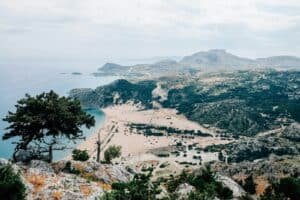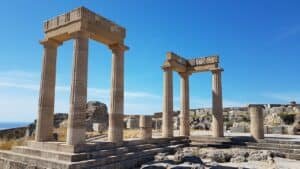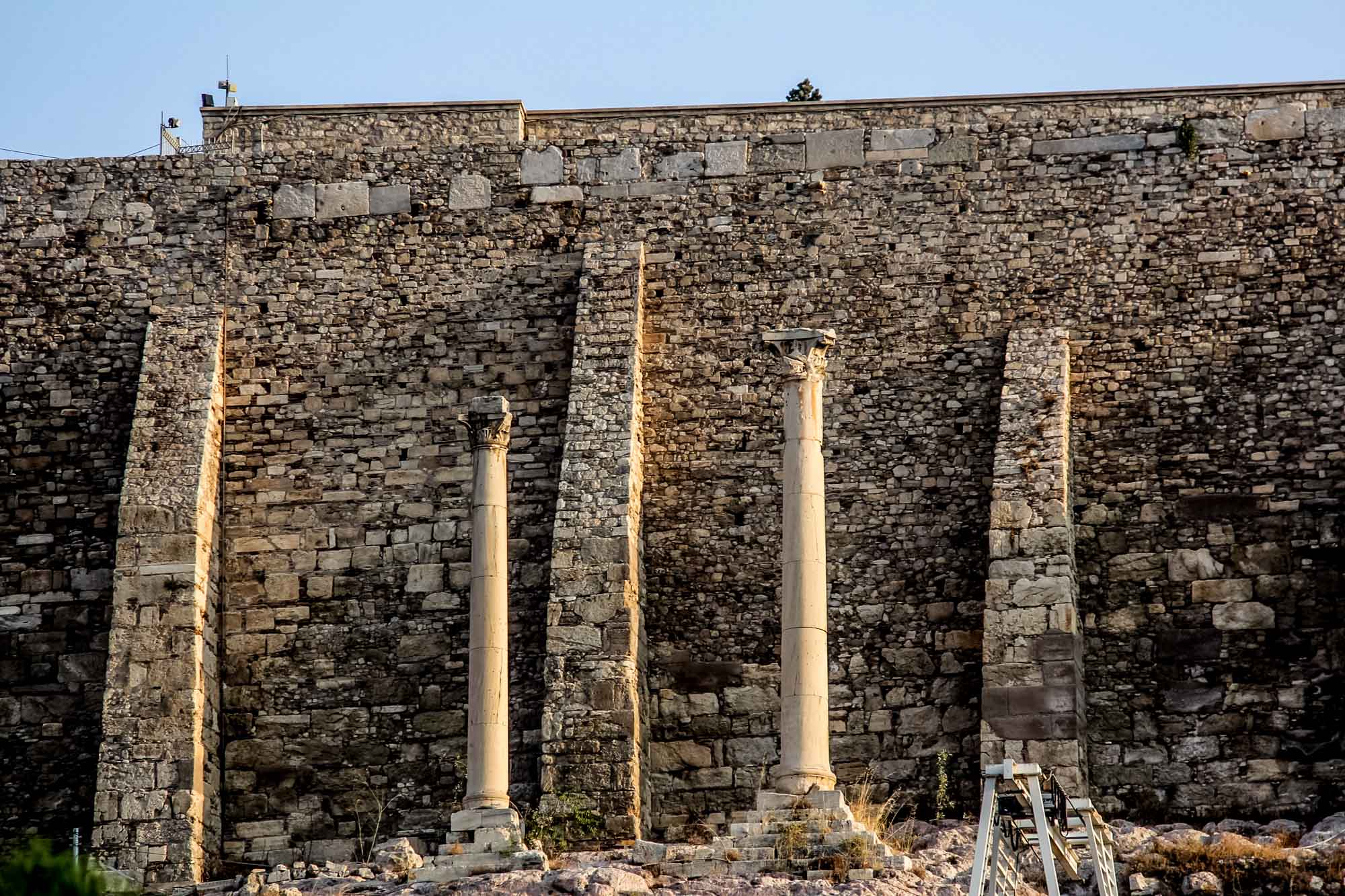Palace of the Grand Master of the Knights of Rhodes
The Palace of the Grand Master of the Knights of Rhodes, dating back to the 14th century, was initially a fortress for the Knights Hospitaller. It later
Known for its history, lovely people, sun, sea, islands with perfect beaches, and tasty and quality dishes, Greece is a premier travel destination. The natural beauty of Greece with the largest coastline in Europe is unbeatable. Whether you are a history buff or prefer a quiet vacation lounging on the beach or maybe you are looking for an alternative extreme sport-filled vacation — whatever your pleasure, Greece is sure to please! In this Greece travel guide, you will find the top places to visit, Greece travel tips, and more.
Athens – Referred to as the historical capital of Europe, Athens is an attractive modern city with unrivaled charm. This city has lots of tourist attractions which include the Parthenon, the Acropolis Museum, and the ancient agora.
Mykonos – This is the second most visited island. You can’t mention Mykonos without referring to the nightlife activities, which center around the town and are famous for their stylish eateries, bars, and clubs. You can also check out Paraportiani (a whitewashed church in Mykonos Town) and numerous sandy beaches along the island’s south coast.
Nafplio – Often cited as Greece’s most beautiful city, Nafplio is a car-free old city filled with neo-classical mansions, and churches and overlooked by the 18th-century Palamidi Fortress.
Crete – Known as the birthplace of both the king of the Olympian gods and of modern European civilization, Crete is a Mediterranean jewel. Soak up the charming atmosphere of Chania Town’s Old Venetian Harbor or the fortresses and monasteries of Rethymnon.
Thessaloniki – Known as the country’s second biggest city after Athens, this city is filled with attractions such as the Byzantine churches, the Triumphal Arch of Galerius and the 4th-century Rotunda and so much more
Santorini – Known as the best destination for most tourists and with such a picturesque backdrop, Santorini is best known for the cliff-top towns of Fira and Oia, which lie on the west coast, overlooking the deep, blue sea-filled caldera.
When planning your trip to Greece, timing can significantly enhance your experience. The best times to visit this stunning destination are during the spring (April to June) and fall (September to October). During these months, the weather is pleasantly warm, and the tourist crowds are less overwhelming, allowing for a more authentic experience.
Spring is particularly enchanting as the landscapes burst into bloom, making it an ideal time for outdoor activities and sightseeing. The mild temperatures are perfect for exploring ancient ruins and enjoying the beautiful beaches without the summer rush.
Similarly, fall offers a wonderful opportunity to enjoy the harvest season, with local festivals celebrating wine and olive oil.
Summer (July to August) is peak tourist season in Greece, especially on the islands like Santorini and Mykonos. While the vibrant atmosphere and lively events are appealing, be prepared for higher prices and larger crowds. If you prefer a more relaxed vacation itinerary, consider visiting during the shoulder seasons of spring or fall.
For those looking for a unique experience, winter (November to March) can also be a great time to visit, particularly for exploring the mainland and enjoying the local culture without the tourist influx. However, some islands may have limited services during this period.
In our opinion, for the best experience in Greece, refer back to this Greece travel guide and consider planning your vacation itinerary ideas around the spring or fall months. However if you’re interested in history, culture, or simply soaking up the sun, Greece has something to offer year-round!
By plane, train, car, ship, or even a combination of transportation means, traveling to Greece is relatively simple and quick.
By Plane: The easiest way to get to Greece is to fly, and there are direct flights to a variety of Greek airports from a lot of major European airports with the two 2 main and busiest airports being the Athens International Airport Eleftherios Venizelos (ATH) and The Airport of Thessaloniki (SKG). If you are starting point is North America, Australia, New Zealand, or South Africa, the most cost-effective way to Greece may well be to get to London, Amsterdam, Frankfurt, another Northern European hub, or even Istanbul– and pick up an onward flight from there.
By Train: All international and some domestic Greek rail routes have been halted as a result of the economic crisis in Greece. You could still ride the train to one of the ferry port cities below in Italy the continue on via boat.
By Ferry: You can choose from four ports while sailing from Italy to Greece; although ferries operate all year long, services are reduced from December to April. Bari and Brindisi are connected to Corfu, Igoumenitsa (the port of the western Greek peninsula), and Pátra by the quickest and most frequent boats (at the northwest tip of the Peloponnese). Additionally, ferries operate between Ancona and Venice and Pátra via Igoumenitsa/Corfu.
By Car: If you have lots of time to take your time traveling, driving to Greece might be enjoyable. Only if you wish to explore along the way is it worth taking into account.
When planning your trip to Greece, understanding the various modes of transportation available is essential for a smooth travel experience. This Greece travel guide will help you navigate your way through this beautiful country, whether you’re hopping between islands or exploring the mainland.
Greece has several domestic airports that connect its many islands and cities. Here are some of the most popular ones:
Several airlines operate domestic flights within Greece, making it easy to reach your desired destination:
Pros: Quick and efficient for long distances; connects to many islands and cities.
Cons: Can be expensive, especially during peak season; potential delays due to weather conditions.
Ferries are a popular way to travel between the Greek islands. Major ferry companies include:
Pros: Scenic views of the Aegean Sea; a chance to explore multiple islands in one trip.
Cons: Travel times can be lengthy; schedules may vary based on weather conditions.
Within cities, public transportation is efficient and affordable. Options include buses, trams, and the metro system in Athens.
Pros: Cost-effective; extensive network covering major areas.
Cons: Can be crowded during peak hours; limited service in rural areas.
Renting a car is a great way to explore Greece at your own pace. Major rental companies include:
Pros: Flexibility to explore off-the-beaten-path locations; convenient for families.
Cons: Parking can be challenging in cities; additional costs for fuel and insurance.
With these transportation options, you can easily navigate Greece and make the most of your travel experience. Whether you prefer the speed of air travel, the scenic routes of ferries, or the freedom of a rental car, Greece has something to offer every traveler.
1. Try to always have cash with you Unlike other European countries, Greece is big on cash, so make sure to have enough money with you as you may find Eat and Drinks and establishments that do not accept credit cards.
2. Book Early – The earlier you reserve your hotel or tickets during the busy season, the more affordable they will be.
Travelers should be aware that islands and ferries are congested during the summer season (mid-July to the end of August) because both Greeks and foreigners are on vacation.
3. Eat and drink like a local Eating is invariably a casual affair in Greece. Look out for the Eat and Drinks that the locals dine in as the food will be much better. Just remember that Greeks eat late – often after 10 pm. Also, try the lamb shank!
4. Don’t Be Afraid To Ask For WiFi Except in remote and isolated places, you can get an internet connection virtually anywhere. WiFi spots are available in many public spaces, as well as in hotels and cafés/bars. Don’t be afraid to ask for the password if the connection is secured; this is common practice in Greece.
5. Taste Raki or Ouzo You can shoot it, drink it, or in the most popular manner, combine it with water so it goes down a little easier.
6. Driving in Greece can be wild The roads are often narrow and if you are on the coastline very windy. The speed limit signs aren’t always available so sometimes you don’t even know what the speed limit is.
7. Step back to ancient times There are so many fantastic Greek ruins that it would be impossible to see them all in one trip but you should be sure to visit a few.
8. Try to island hop there is no reason you have to limit yourself to just one island. You can organize an island-hopping excursion. While island-hopping can complicate tourism in Greece, it is possible and can result in a richly varied cultural experience.
Price Range for Hotels
Depending on the area of Greece you are traveling to, the cost of accommodation varies. You can find dorm rooms in hostels for about 10-35 EUR per bed a night. Hotels and guesthouses cost 40-100 EUR per night while luxurious hotels can cost 150-300 EUR per night. On Airbnb, you can find shared rooms or apartments for as low as 10 EUR in many cities and entire homes (including studio apartments) can be rented on the low-end for 50 EUR.
Cost of Meal
Food in Greece is quite affordable and shouldn’t eat into your budget too much. The cheapest meal in Greece is one pita souvlaki (wrapped souvlaki) that costs about 3 EUR and you can even take it to-go. Most cafes will cost you around 12 EUR for a meal. A meal at a very luxurious Eat and Drink will begin at 30 EUR. A three-course meal with bottled wine starts from 50-70 EUR per person or more. However, if you cook your meals, expect to pay 35-45 EUR per week for groceries that will include pasta, vegetables, chicken, and other basic foods.
The Palace of the Grand Master of the Knights of Rhodes, dating back to the 14th century, was initially a fortress for the Knights Hospitaller. It later

Tsambika Beach, often referred to as Tsampika, is a cherished destination on the island of Rhodes, Greece. Nestled on the eastern coast, this stunning beach features golden

Introduction The Lindos Acropolis, situated on a hill in the charming village of Lindos on the island of Rhodes, Greece, is an essential archaeological site that showcases
Agia Sofia Cav Nestled on the stunning island of Kythira, Greece, the Agia Sofia Cave is an essential destination that combines breathtaking natural scenery with historical and
Introduction Sarakiniko Beach, situated on the northern shore of Milos Island in Greece, is a stunning destination renowned for its otherworldly landscape. The beach features striking white
Introduction Olympus National Park, situated in Greece, is a stunning destination that combines natural splendor with mythological importance. It is home to Mytikas, the highest peak in

Athens Greece Photos
You are't logged in
• Create Travel Plans/Trips
• Collect Places You've Been
• Connect with Like-Minded Travelers
• Contribute to the Community by Posting New Recommendations
Already Registered? Login.
